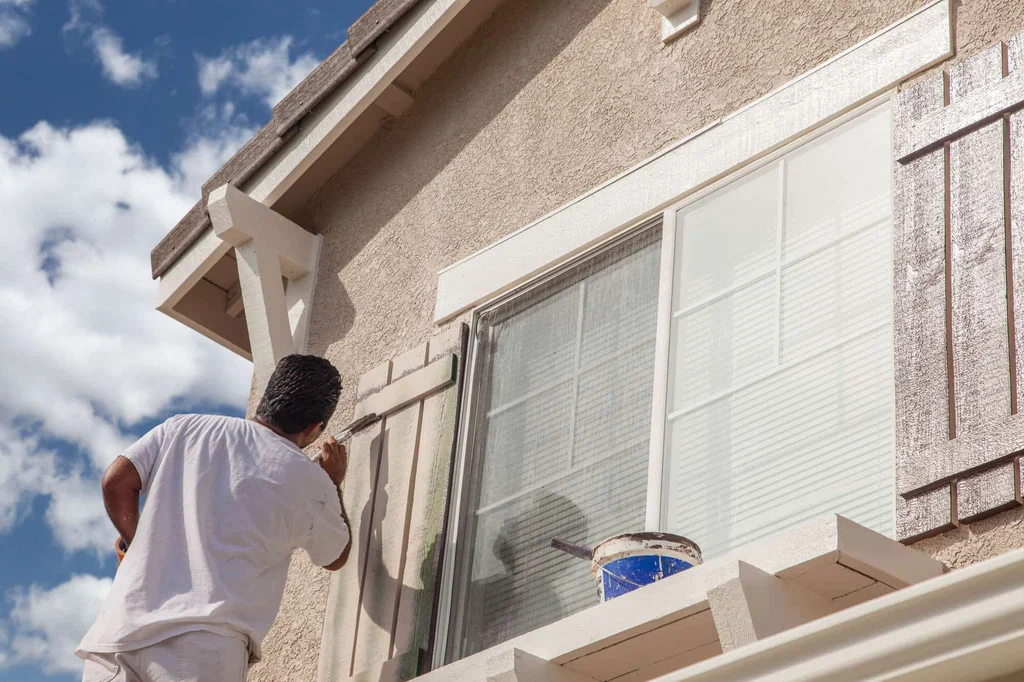A fresh coat of paint doesn’t just change the color of your house it changes the way it feels, how people see it, and how well it stands up to nature. But outdoor painting is not as simple as opening a paint can and getting to work. Timing is everything. If you don’t paint in the right month or under the right conditions, your paint job might not last long.
So, what is the best month to paint outside? And how can you ensure the work appears smooth, clean and lasts for years?
This post has the answers and more. We’ll discuss the best times of the year to paint, the weather for exterior painting that is optimal, and how to prepare. We’ll provide 5 pro tips and key insights on winter painting, exterior paint in cold weather, and how to read the longer weather forecast before you start. Let’s dive in.
Why Timing Matters in Exterior Painting
Outdoor painting is very different from painting indoors. Outside, you have to deal with:
- Temperature changes
- Rain, snow, and wind
- Humidity levels
- Sun exposure
- Morning dew or frost
If your wet paint gets rained on or dries too fast in the hot sun, the paint can crack, peel, or look uneven. Even if the paint appears fine right after applying, it might fail over time if the weather wasn’t right when you painted.
The paint needs time to cure (dry and harden), and that only happens well under specific conditions.
It is recommended to check the extended weather forecast. You want several dry, mild days in a row for the best results.
Best Time of Year to Paint Outside
Spring Painting
Best Months: Late March-May
Spring is a great time to refresh your home’s look. The weather starts to warm up, and it’s easier to find a few dry days. But you have to be careful of:
- Sudden rain showers
- High pollen levels
- Morning dew
Tips for Spring Painting:
- Wait until temperatures stay above 50°F consistently, especially at night.
- Paint mid-morning, after the dew dries but before the sun is too strong.
- Keep your surfaces clean from pollen before applying fresh paint.
Pros:
- Moderate temps help paint cure properly.
- Easier to schedule your project early in the year.
Cons:
- Wet weather can ruin a fresh coat of paint.
- Allergens and debris may stick to wet paint.
Summer Painting
Best Months: June – Early September
Summer is a favorite for many DIYers. There are long, sunny days and less rain in most areas. But also keep in mind that high temperatures and strong sun can also cause problems.
Tips for Summer Painting:
- Paint in the early morning or evening to avoid peak heat.
- Don’t paint in direct sunlight. Shade is your friend.
- Get UV-resistant paint to prevent fading.
Pros:
- The paint dries faster.
- Lower chances of rain interrupting your project.
Cons:
- Extreme heat can make the paint dry too fast, leaving brush marks.
- Extremely hot temperatures can cause blistering or peeling.
Fall Painting
Best Months: September – October (sometimes into early November)
Fall is often the best time to paint outdoors. Temperatures are cooler, the humidity drops, and there’s less pollen in the air.
Tips for Fall Painting:
- Start earlier in the day since daylight hours are shorter.
- Make sure overnight temps stay above 50°F.
- Use cold-weather exterior paint if temps dip below 55°F.
Pros:
- Paint cures evenly.
- More consistent weather, less rainfall.
- Weather with lower humidity is ideal for a lasting finish.
Cons:
- Less daylight means less time to work.
- Cold nights may delay drying time.
Winter Painting
Best Months: Only in warmer climates or with the right products
Most homeowners avoid winter painting unless they live in mild southern states. In freezing temps, paint won’t dry properly and may crack or peel.
Tips for Winter Painting:
- Only paint if the daytime and nighttime temps stay above 50°F.
- Use specially formulated cold-weather exterior paint.
- Watch for frost or dew in the morning before applying paint.
Pros:
- Fewer insects and pollen.
- Little to no humidity in some climates.
Cons:
- The paint won’t cure well below 50°F.
- Wet paint can freeze or streak.
5 Expert Tips for Better Exterior Painting
- Check the Extended Weather Forecast. Always plan at least 3–5 days. Avoid rain, wind, or extreme cold. Consistent mild weather helps ensure a smooth finish and proper curing.
- Use the Right Paint for the Season. In cooler months, opt for cold-weather exterior paint that cures in lower temps. In summer, choose UV-resistant options that don’t fade or crack.
- Prep Is Key. Wash the surface, remove old paint, and repair any damage before applying your fresh coat of paint. Clean, dry surfaces help paint stick better and last longer.
- Don’t Rush the Dry Time. Even if it looks dry, the paint continues to cure for days. Avoid rain or washing surfaces too soon. Give it time to bond fully.
- Avoid Painting in Direct Sunlight. Direct sun can make the paint dry too quickly, trapping moisture or causing streaks. Work in the shade or when the sun has moved past.
What Happens If You Paint in the Wrong Weather?
If you ignore weather conditions, here’s what can go wrong:
- Peeling or cracking within weeks
- A sticky or tacky finish that never fully dries
- Faded colors from sun damage
- Bubbles or blisters from trapped moisture
These issues aren’t just cosmetic. It can lead to damage underneath the paint, like wood rot or water intrusion.
Should You Hire a Pro or Do It Yourself?
Painting outside may seem simple, but professional painters understand how to time everything just right. They know:
- When to use cold-weather exterior paint
- How to avoid painting over wet paint
- The perfect time of day to start and stop
- Which weather conditions give long-lasting results
Pro also has the tools and experience to complete the job quickly and safely, especially if your home is two stories or more.
FAQs about Exterior Painting
- Can you paint in cold weather?
Yes, but only with cold-weather exterior paint and if the temperature stays above 50°F during the day and night. - What’s the best weather for exterior painting?
Dry, mild days between 55°F–75°F with humidity between 40% -70%. Avoid rain and strong sun. - How long should I wait to paint after it rains?
Wait at least 24 hours, and make sure the surface is completely dry before painting. - Can I paint over old paint?
Yes, if the surface is clean and the old paint isn’t peeling. If it is, scrape and sand before applying new paint. - How long should exterior paint last?
With proper prep and weather-friendly timing, a paint job can last 5–10 years or more.
Final Thoughts: What’s the Best Month to Paint Outside?
If you want the best possible results, aim for early fall or late spring. These months usually offer the best weather for exterior painting: steady temperatures, low humidity, and minimal rainfall. Avoid painting in cold weather unless you have the right products and know what you’re doing.
Remember: always check the extended weather forecast, use the right tools, and don’t rush the process. And if you’re not sure, you can do it alone…
Trust the Pros at Carter’s Painting Services
When you want a smooth, long-lasting finish without the stress, Carter’s Painting Services is here to help. We use the best cold-weather exterior paint, keep an eye on every detail (including that extended weather forecast!), and ensure your home gets a beautiful, weather-proof paint job.
Get a free estimate today and give your home a fresh coat of paint; done right, in the right season. Visit Carter’s Painting Services for more details.


